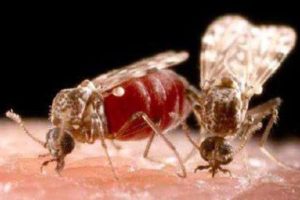Notes On Schmallenberg Virus (SBV)
6 September 2017 Schmallenberg virus was first seen in parts of Germany and the Netherlands in summer 2011. It was diagnosed in southern England in March 2012 and the first Scottish cases were seen in 2013 in the Dumfries area and with a cluster in Aberdeenshire.
Schmallenberg virus was first seen in parts of Germany and the Netherlands in summer 2011. It was diagnosed in southern England in March 2012 and the first Scottish cases were seen in 2013 in the Dumfries area and with a cluster in Aberdeenshire.
Very little was seen of the virus from 2014-2016, but it has re-emerged this spring with a large number of cases in Cumbria and Northumberland and more worryingly in Southern Scotland in the Dumfries area and Roxburghshire/Selkirkshire areas of the Scottish Borders.
SBV is an orthobunyavirus and is transmitted by the biting insect members of the culicoides family (midge).
Signs
Main clinical signs of SBV are the birth of lambs/calves which have deformed and fused limbs and spine and reduced development of parts of the brain. Many require to be delivered by caesarean section. Infection in cattle at around days 30 – 150 days of pregnancy and sheep around 30 – 70 days of pregnancy are thought to be the crucial times for abnormalities to occur in the developing foetus. However not all infected cows and ewes give birth to congenitally malformed offspring.
When non-pregnant animals are infected by SBV, they will experience a short fever for a few days and be off colour, and some can have diarrhoea. There can be a sudden milk drop in milking cows. Generally these animals will then have good immunity to the virus and can show antibodies in their blood for a number of years.
In flocks/herds where virus has been present, the level of immunity throughout the group is difficult to assess but we know that it is not complete after just 1 year of exposure. Flocks which experienced problems in 2012, also had problems in 2013, so we should expect that if conditions for the vectors are correct, we may still see some issues in flocks across the region next year. We know that the virus can overwinter in the UK.
Treatment
Unfortunately we currently have no vaccine available for control of SBV. It takes a lot of time and money to get a vaccine to selling stage and none of the pharmaceutical companies have been willing to take it on. Cost issues and perceived lack of uptake are the likely reasons why.
Vaccine would have been particularly well received in early lambing flocks (Jan/Feb) where losses were high in some flocks. These animals are in early pregnancy when the highest risk of vectors is present i.e. July/August, although with last winter having no official “vector-free” months, there would appear to be risks for all flocks and herds no matter when they are lambing/calving.
Some farmer have used cypermethrin pour-on preparations in an attempt to deter the midges from biting cattle and sheep – success of this is anecdotal and no studies have been done. Provided these preparations are used at the correct dosage, they are unlikely to cause any damage.
Free surveillance testing of deformed foetuses was offered in the spring of the year and free testing is still being offered to investigate suspected acute cases. If your cows have a milk drop and cows with fever, or in all cattle, fever and diarrhoea in seen in 2 or more cattle over 3 months old during a 1 week period, then you and your vet should consider sampling animals for acute SBV. More information is available from your vet or your local SAC Consulting VI Centre.
Kath Dun, kath.dun@sac.co.uk
Sign up to the FAS newsletter
Receive updates on news, events and publications from Scotland’s Farm Advisory Service
